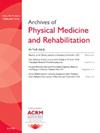Effectiveness of mHealth Interventions to Improve Pain Intensity and Functional Disability in Individuals With Hip or Knee Osteoarthritis: A Systematic Review and Meta-analysis
IF 3.6
2区 医学
Q1 REHABILITATION
Archives of physical medicine and rehabilitation
Pub Date : 2025-02-01
DOI:10.1016/j.apmr.2024.06.008
引用次数: 0
Abstract
Objective
This review aimed to investigate the effectiveness of mHealth-supported active exercise interventions to reduce pain intensity and disability level in persons with hip or knee osteoarthritis (OA).
Data Sources
Three databases (PubMed, Cochrane Library, and Web of Science) were systematically searched for randomized controlled trials (RCTs) published between January 1, 2012 and July 31, 2023. PROSPERO registration number of this review was CRD42023394119.
Study Selection
We included only RCTs that were identified and screened by 2 independent reviewers (J.M. and G.N.). In addition, the reference lists of the identified studies were manually checked for further inclusion. Included studies had to provide mHealth-supported active exercises for persons with hip or knee OA, and evaluate pain intensity and disability using both questionnaires and performance tests.
Data Extraction
From the included studies, the 2 independent authors extracted data using a predetermined Excel form. Characteristics of the interventions were described and a meta-analysis was performed.
Data Synthesis
Twelve RCTs were included, representing 1541 patients with a mean age of 58.7±5 years, and a body mass index of 28.8±3.1 kg/m2; women being more predominant than men with a total female to male ratio of 2.2. The methodological quality of the included studies was moderate in 75% of the studies. There was no statistically significant difference between mHealth-supported active exercises compared with the interventions without mHealth in terms of pain reduction (standard mean differences [SMD]=−0.42; 95% CI, −0.91 to 0.07; P=.08) and disability mitigation (SMD=−0.36; 95% CI, −0.81 to 0.09; P=.10). However, a statistically significant difference was found between patient education combined with mHealth-supported active exercises compared with patient education alone in terms of pain (SMD= −0.42; 95% CI, −0.61 to −0.22; P<.01) and disability (SMD=−0.27; 95% CI, −0.46 to −0.08; P<.01) reduction.
Conclusions
mHealth-supported exercises were found to be effective, especially when combined with patient education, in reducing pain and mitigating disability in patients with hip or knee OA.
移动医疗干预对改善髋关节或膝关节骨关节炎患者疼痛强度和功能障碍的效果:系统综述和荟萃分析。
目的本综述旨在研究移动医疗支持的积极锻炼干预对降低髋关节或膝关节OA患者疼痛强度和残疾程度的有效性:系统检索了三个数据库(PubMed、Cochrane Library 和 Web of science)中 2012 年 1 月 1 日至 2023 年 7 月 31 日期间发表的随机对照试验 (RCT)。本综述的 PROSPERO 注册号为 CRD42023394119:我们仅纳入了由两名独立审稿人(JM 和 GN)确认和筛选的 RCT。此外,我们还对已确定研究的参考文献列表进行了人工检查,以进一步纳入研究。纳入的研究必须为髋关节或膝关节 OA 患者提供移动医疗支持的主动运动,并使用问卷调查和表现测试评估疼痛强度和残疾情况:两位独立作者使用预先确定的 Excel 表格从纳入的研究中提取数据。数据综合:共纳入了 12 项 RCT 研究:共纳入 12 项研究,代表 1,541 名患者,平均年龄为(58.7±5)岁,体重指数为(28.8±3.1);女性多于男性,女性/男性总比例为 2.2。75%的纳入研究的方法学质量为中等。在减轻疼痛(SMD= -0.42 [95%CI -0.91; 0.07],p = 0.08)和减轻残疾(SMD = -0.36 [95%CI -0.81; 0.09],p = 0.10)方面,有移动医疗支持的积极锻炼与没有移动医疗支持的干预相比,没有统计学意义上的显著差异。然而,在疼痛方面,患者教育结合移动医疗支持的主动锻炼与单独的患者教育相比,发现两者之间存在统计学意义上的显著差异(SMD=-0.42 [95%CI -0.61; -0.22],p 结论:研究发现,移动医疗支持的锻炼能够有效减轻髋关节或膝关节 OA 患者的疼痛并减轻其残疾程度,尤其是在结合患者教育的情况下。
本文章由计算机程序翻译,如有差异,请以英文原文为准。
求助全文
约1分钟内获得全文
求助全文
来源期刊
CiteScore
6.20
自引率
4.70%
发文量
495
审稿时长
38 days
期刊介绍:
The Archives of Physical Medicine and Rehabilitation publishes original, peer-reviewed research and clinical reports on important trends and developments in physical medicine and rehabilitation and related fields. This international journal brings researchers and clinicians authoritative information on the therapeutic utilization of physical, behavioral and pharmaceutical agents in providing comprehensive care for individuals with chronic illness and disabilities.
Archives began publication in 1920, publishes monthly, and is the official journal of the American Congress of Rehabilitation Medicine. Its papers are cited more often than any other rehabilitation journal.

 求助内容:
求助内容: 应助结果提醒方式:
应助结果提醒方式:


